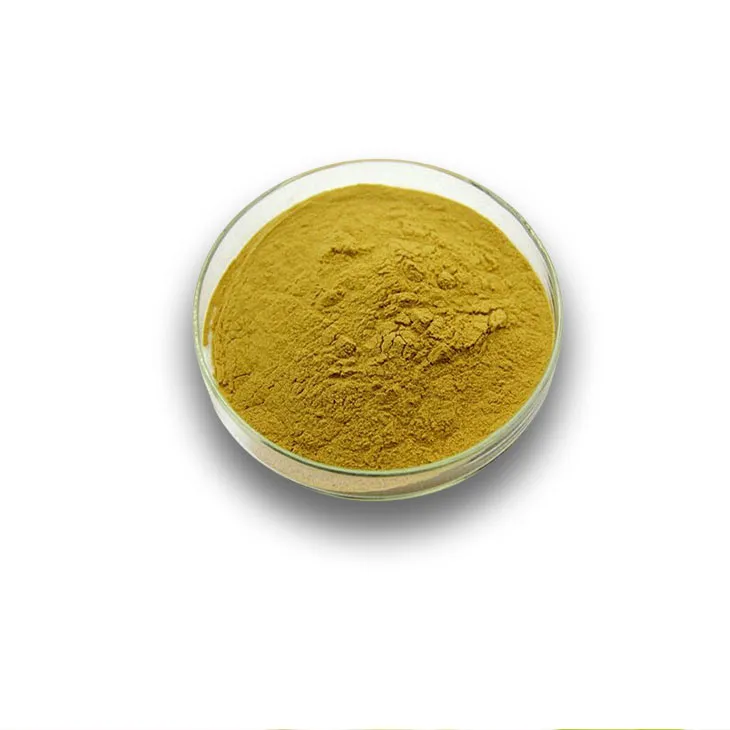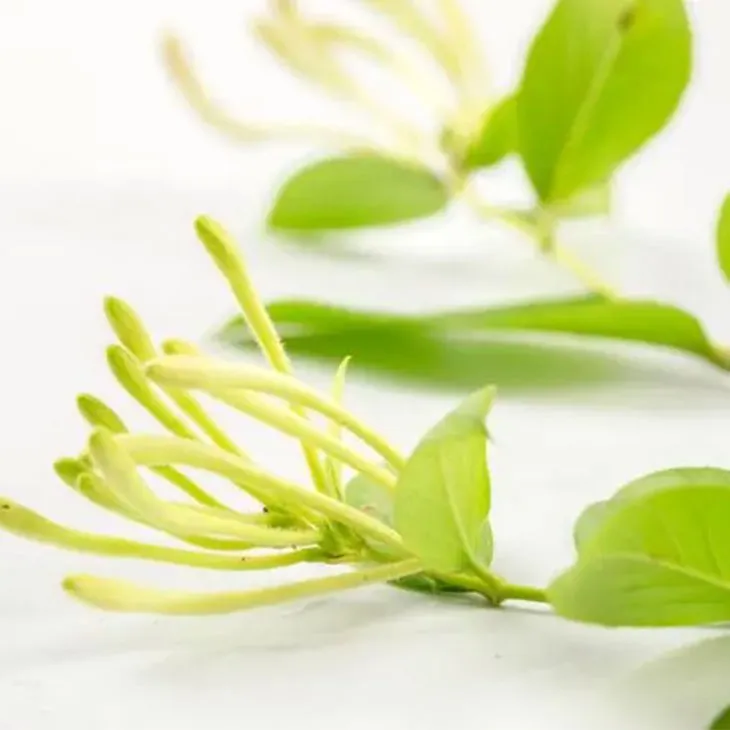- 0086-571-85302990
- sales@greenskybio.com
Honeysuckle pollen: From leaves to extraction.
2024-11-12

1. Introduction
Honeysuckle, with its beautiful appearance and rich medicinal value, has attracted much attention. Among its various components, Honeysuckle Pollen is of particular interest. This article will comprehensively explore the journey from honeysuckle leaves to the extraction of its pollen, as well as the significance of this pollen in different fields.

2. Honeysuckle Leaves: Characteristics and Role in the Ecosystem
2.1 Physical Characteristics
Honeysuckle leaves typically have an oval or lanceolate shape. They are often green in color, which is due to the presence of chlorophyll. The surface of the leaves may be smooth or slightly hairy, depending on the species. For example, the leaves of some wild honeysuckle species may have a fine layer of hairs, which can help protect the leaves from excessive sunlight and some pests.
2.2 Chemical Composition
The leaves of honeysuckle contain a variety of chemical substances. These include flavonoids, such as rutin and Quercetin. Flavonoids play an important role in antioxidant activities, which can help protect the plant from oxidative stress. In addition, there are also some phenolic acids in the leaves, like caffeic acid. These substances contribute to the overall defense mechanism of the plant against diseases and pests.
2.3 Role in the Ecosystem
- Honeysuckle leaves are an important part of the photosynthesis process. Through photosynthesis, the leaves convert carbon dioxide and water into organic matter and oxygen, providing energy for the growth and development of the entire plant. This process also has a positive impact on the surrounding environment by increasing the oxygen content in the air.
- The leaves also serve as a habitat and food source for some small insects and animals. For instance, certain butterfly larvae feed on honeysuckle leaves. This interaction between plants and animals is an essential part of the ecological balance.

3. The Pollen of Honeysuckle: Structure and Properties
3.1 Microscopic Structure
Under the microscope, Honeysuckle Pollen has a unique structure. It usually has a spherical or oval shape, with a relatively smooth outer wall. The surface of the pollen may be decorated with some fine granules or ridges, which are important for its identification and also play a role in its adhesion and dispersal. These microscopic features can vary among different species of honeysuckle, providing a basis for scientific classification.
3.2 Chemical Properties
- Honeysuckle Pollen contains a rich variety of nutrients. It is rich in proteins, which are the building blocks for many biological processes. These proteins can be further divided into different types, such as enzymes and structural proteins.
- It also contains vitamins, such as vitamin C and some B - group vitamins. Vitamin C is well - known for its antioxidant properties, while B - group vitamins play important roles in metabolism.
- Another important component in honeysuckle pollen is amino acids. Essential amino acids, which cannot be synthesized by the human body, are also present in the pollen. These amino acids are necessary for the synthesis of proteins in the human body.

4. Extraction Process of Honeysuckle Pollen
4.1 Collection of Honeysuckle Flowers
The first step in the extraction of honeysuckle pollen is the collection of honeysuckle flowers. This should be done at the appropriate time. Usually, when the flowers are in full bloom, they are rich in pollen. The collectors need to be careful not to damage the flowers during the collection process, as damaged flowers may lead to a decrease in pollen quality. It is also important to choose healthy and pest - free flowers.
4.2 Pollen Separation
- One common method for pollen separation is mechanical separation. This involves using special tools or machines to gently shake or vibrate the flowers to release the pollen. For example, a small - scale operation may use a simple vibrating device to separate the pollen from the flowers.
- Another method is air - flow separation. By creating a controlled air - flow, the lighter pollen can be separated from the heavier flower parts. This method requires precise control of the air - flow speed and direction to ensure efficient separation.
4.3 Purification of Pollen
After separation, the pollen needs to be purified. This may involve removing impurities such as dust, small flower debris, and other foreign substances. One way to purify the pollen is through sieving. Using fine - meshed sieves can effectively remove larger impurities. Additionally, washing the pollen with a suitable solvent can also help remove some soluble impurities. However, care must be taken to ensure that the solvent does not damage the pollen or remove important components.

5. Significance of Honeysuckle Pollen in Different Fields
5.1 Traditional Medicine
In traditional medicine, honeysuckle pollen has been used for centuries. It is believed to have certain medicinal properties. For example, it is often used to relieve symptoms of fever and inflammation. The anti - inflammatory properties of honeysuckle pollen may be attributed to its rich content of flavonoids and other bioactive substances. It can also be used to soothe the throat and relieve coughs, making it a popular ingredient in some herbal remedies.
5.2 Cosmetics
- Honeysuckle pollen is also finding its way into the cosmetics industry. Due to its antioxidant properties, it can be added to skincare products to help prevent skin aging. The antioxidants in the pollen can neutralize free radicals, which are known to cause damage to skin cells.
- It also has moisturizing properties. The proteins and amino acids in the pollen can help improve the skin's moisture - retaining ability, leaving the skin soft and supple.
5.3 Food Industries
- In the food industry, honeysuckle pollen can be used as a natural food additive. It can add a unique flavor to food products. The slightly sweet and floral flavor of the pollen can enhance the taste of some desserts, beverages, and confectionery items.
- Moreover, because of its rich nutritional content, it can also be used to develop functional foods. These are foods that not only provide basic nutrition but also offer additional health benefits. For example, products containing honeysuckle pollen may claim to boost the immune system or improve digestion.
6. Conclusion
Honeysuckle pollen, from the leaves of the honeysuckle plant to its extraction, is a complex and interesting process. The leaves play a crucial role in the plant's growth and the overall ecosystem. The extraction of pollen involves several important steps to ensure its quality. And the significance of honeysuckle pollen in traditional medicine, cosmetics, and food industries cannot be ignored. As research continues, it is expected that more potential applications and benefits of honeysuckle pollen will be discovered in the future.
FAQ:
What are the main characteristics of honeysuckle leaves?
The honeysuckle leaves typically have certain shapes, such as oval or lance - shaped. They are often green in color and have a smooth or slightly hairy texture. The leaves play important roles in processes like photosynthesis, which is crucial for the plant's growth and survival. They also contribute to the overall structure and appearance of the honeysuckle plant in its ecosystem.
What are the common methods for extracting honeysuckle pollen?
Some common extraction methods include mechanical methods, where physical means are used to separate the pollen from the plant parts. Another approach could be solvent - based extraction, which uses appropriate solvents to dissolve and isolate the pollen. There may also be methods that involve air - drying the plant parts first and then using gentle shaking or brushing techniques to collect the pollen.
How is honeysuckle pollen used in traditional medicine?
In traditional medicine, honeysuckle pollen may be used for its potential anti - inflammatory properties. It could be prepared in the form of tinctures, powders, or infusions. It may be used to treat various ailments like respiratory infections or fevers. However, it should be used with caution as improper use can lead to adverse effects.
What are the potential benefits of honeysuckle pollen in the cosmetics industry?
Honeysuckle pollen may have antioxidant properties which can be beneficial in cosmetics. It can help in protecting the skin from damage caused by free radicals. It may also have moisturizing and nourishing effects on the skin, potentially improving skin texture and appearance. Additionally, it might have anti - aging properties that can be incorporated into anti - wrinkle creams or other skin - care products.
What makes honeysuckle pollen suitable for the food industry?
Honeysuckle pollen can add a unique flavor to food products. It may also have some nutritional value, such as containing certain vitamins or minerals. In some cases, it can be used as a natural food coloring agent. However, strict regulations need to be followed regarding its use in the food industry to ensure safety.
Related literature
- The Botany and Chemical Composition of Honeysuckle"
- "Extraction Techniques for Plant Pollen: A Case Study of Honeysuckle"
- "Honeysuckle Pollen in Traditional Chinese Medicine: A Review"
- "The Role of Honeysuckle Pollen in Cosmetic Formulations"
- "Utilization of Honeysuckle Pollen in the Food Industry: Current Trends and Future Prospects"
- ▶ Hesperidin
- ▶ Citrus Bioflavonoids
- ▶ Plant Extract
- ▶ lycopene
- ▶ Diosmin
- ▶ Grape seed extract
- ▶ Sea buckthorn Juice Powder
- ▶ Fruit Juice Powder
- ▶ Hops Extract
- ▶ Artichoke Extract
- ▶ Mushroom extract
- ▶ Astaxanthin
- ▶ Green Tea Extract
- ▶ Curcumin
- ▶ Horse Chestnut Extract
- ▶ Other Product
- ▶ Boswellia Serrata Extract
- ▶ Resveratrol
- ▶ Marigold Extract
- ▶ Grape Leaf Extract
- ▶ New Product
- ▶ Aminolevulinic acid
- ▶ Cranberry Extract
- ▶ Red Yeast Rice
- ▶ Red Wine Extract
-
Red Vine Extract
2024-11-12
-
Marigold Extract
2024-11-12
-
American Ginseng Root Extract
2024-11-12
-
Ginseng Root Extract
2024-11-12
-
Nettle leaf extract
2024-11-12
-
Alisma Extract
2024-11-12
-
Aguaje Extract
2024-11-12
-
Oyster Mushroom Extract Powder
2024-11-12
-
Coix Seed Extract
2024-11-12
-
Panax Ginseng Leaf Extract
2024-11-12





















